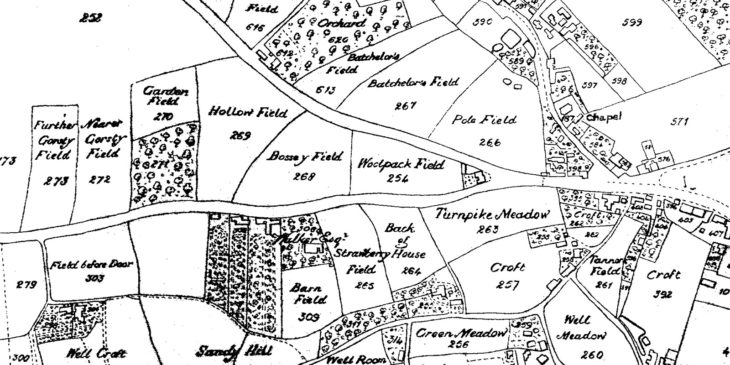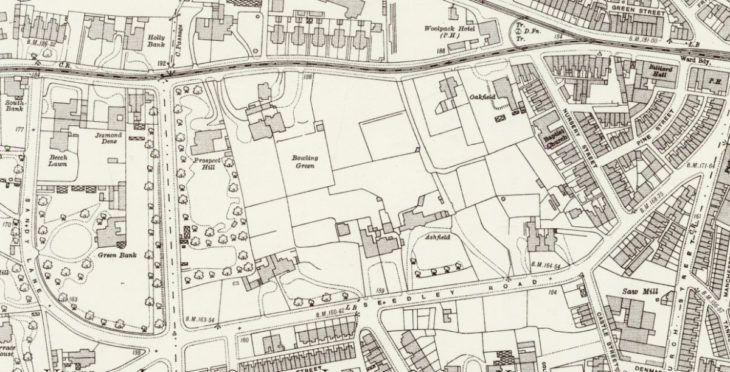Belmont 2
1815 Pendleton Township map shows no building on plot 265 marked as ‘Strawberry Field’. Within around six years this would be the site of a pair of substantial semi-detached villas known as Belmont.

1821 We do not know exactly when the houses were built. The Manchester Guardian of 15 December 1821 announced the marriage of Mary Smith of Belmont to Henry Withington, merchant of Eccles, so we can deduce that building occurred between 1815 and 1821.
1828 Pendleton Land Tax records show that in 1828 there were two dwellings on the Belmont site. James Withington (uncle of Henry) owned both properties. James was a merchant who lived in Ashfield on Seedley Road, just south of Belmont, so we can deduce that building occurred between 1815 and 1821. The Belmont houses were occupied by Samuel Smith (Mary’s father) and Nathaniel Tidmarsh, a calico printer, who had been living at The Crescent in 1825. The Belmont houses were assessed for land tax at 3s 11d each.
1830 Nathaniel Tidmarsh was still in occupancy of Belmont 2. He originally came from Gloucestershire and had lived in the Manchester area since at least 1817 (when he signed a resolution of the Manchester Magistrates condemning the movement for Parliamentary reform). He is thought to have died around 1834.
1838 A letter to John Benjamin Smith from Rev. Hugh Stowell in 1838 indicates that Smith was resident at Belmont by this time. Having made his wealth in his father’s textile firm of Benjamin Smith & Sons, John Benjamin had retired from business to follow a career in politics.
1841 The Census return shows John Benjamin Smith (1794-1879) living at Belmont with two female servants. He married later that year and, in poor health, left for Europe where he and his wife spent almost two years. His two daughters were born at Belmont in 1843 and 1844. The family left Belmont in 1845 and moved to Vicarage Field in Eccles. Smith was elected MP for a Scottish constituency in 1847 and then for Stockport in 1852. He was living in London at the time of the 1851 Census.
1848 The first map showing the Belmont houses is the 1848 Ordnance Survey map. What we now know as Eccles Old Road was then Sandy Lane, from its junction with Broad Street to its southward branch (the current Sandy Lane). Langworthy Road had not then been laid.

1851 The Census of 1851 shows that John Carver, a cotton merchant from Leicester, with his wife Lydia and son William John had taken up residence. Their neighbours were Henry Leigh Trafford at Belmont 1 and Samuel Walker at Prospect Hill. Over the next 40 years, the three Carvers would continue living at Belmont until their deaths. John died in 1863, Lydia in 1874 and William John, a shipping merchant, lived on at Belmont supported by servants until dying in 1893.

1898 It appears that no -one lived in Belmont 2 in the years immediately following the death of William Carver in 1893. Trade Directories show no occupants for the house until 1898 when John Edward King is listed.
1899 November records from St James’s Church, Hope show that John Edward King and his wife Mary Temple King baptised their son Denys Penkivil. Their address was given as 15 Eccles Old Road, which was how Belmont 2 was often referred to.
1901 Census shows John Edward King, age 42, High Master of Manchester Grammar School with his wife, three sons and three servants. Also listed was a visitor, Sarah Ann King Carver, who was his first cousin. It is possible that the Kings were related to the previous Carver occupants of Belmont 2.
1903 The King household left Salford when John Edward was appointed Headmaster of Bedford School. The family moved again in 1910 when King relocated back to Bristol on his appointment as Headmaster of his old school Clifton College.
1904 Slater’s Directory indicates that the house was then taken by Dr Philip Worley and his family who had been living close by in Thornhill. The Worleys stayed until 1908, when they moved further down Eccles Old Road to no. 182, Hope House.
1921 Belmont appears to have stood empty next to the Pendleton Bowling Club for over twenty years. It may have been in a poor state of repair when it was taken on by Alfred Laithwaite (18968-1950) and his three sons William, Alfred and Ernest. For the first 15 years or more, the Laithwaites operated as motor cab proprietors, and later as a car hire company.

1938 Alfred Laithwaite listed himself for the first time in the local directory as a ‘Funeral Furnisher’. The brothers had found their niche. Almost one hundred years has passed since Alfred Laithwaite senior moved into Belmont. The house and its grounds have undergone many alterations and extensions. Thousands of Salford residents have no doubt passed through its doors.
Today, the Co-op group owns Laithwaites Funeral Care, keeping the name of the family that founded and ran the business for so many years.